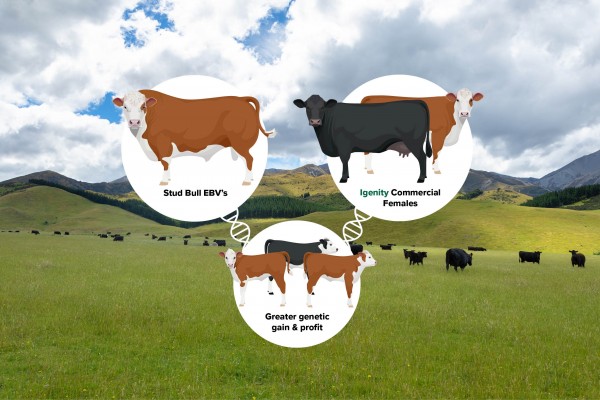Igenity allow farmers to focus time, feed and resources on breeding young stock of verified merit.
The selection of herd replacements in commercial beef herds has until now relied on a judgment call of phenotype, pedigree and performance, an intimidating process given the influence those genetics can play in the future of the herd.
Performance Beef Breeders commonly known as PBB, in Feilding has recently launched Igenity Beef for NZ commercial beef farmers, a tool that helps remove some of the guess work from those decisions.
PBB National Territory Manager Ella Holland says the aim when selecting herd replacements is to choose females that have genetic merit that aligns with selection objectives and avoid unwanted genetic traits.
“Igenity helps remove the guess work of herd replacement selection - giving commercial beef farmers more confidence in the genetic decisions they’re making.”
“Phenotype, pedigree and performance are fine if determining if a female should be culled, but they can be inconclusive when the commercial farmer is comparing middle-performing animals.”
She offered the example of two heifers that have the same sire and look and weigh the same. It can be hard to tell which has a greater genetic merit and is more profitable to retain as a herd replacement - it’s here that Igenity comes in.
Igenity is offered as part of PBBs genomics partnership with Neogen and provides in-herd evaluation that’s been calibrated to NZ beef data.
Ella says it’s an easy-to-use system that harnesses the power of genomics to rank females top to bottom on performance and profitability.
The evaluation is available for straight and cross bred cattle of the following breeds: Angus, Red Angus, Hereford, Limousin, Shorthorn, Simmental and Gelbvieh.
Neogen’s Manager Business Development, APAC Genomics, Dr Pieter van As says the data will allow farmers to make more informed decisions about replacement heifers and mating groups to make the best gains.
It achieves this by utilizing DNA scores (1-10) for 16 maternal, performance and carcass traits to create advanced animal profiles.
Each Igenity score has a corresponding molecular breeding value and it’s this value that is the prediction of how future progeny of an animal are expected to perform compared to the progeny of other profiled animals.
Ella shared an example of a cow with an Igenity average daily weight gain score of eight, producing progeny that will gain 0.036kg more per day than the progeny of a cow with a score of three. The difference in scores means the progeny of the cow with a score of eight will weigh 5.4kg more at 150 days on feed than the other progeny.
All Igenity users are assigned their own dashboard where their herd can be sorted, comparisons made within herd and benchmarking against other herds in the database undertaken. The dashboard also features three selection indexes – maternal, performance and terminal.
“Igenity indexes make selection easy. The indexes allow for selection pressure on multiple traits at the same time, depending on a producer’s breeding objectives.” says Pieter.
“The Igenity profiles provide beef farmers with greater insight into a female’s potential fertility and performance without having to have a calf on the ground. This helps optimize selection decisions on-farm and can help pinpoint any weaknesses and strengths within a herd, leading to greater genetic gain and return on investment.”
Importantly, Ella says, Igenity allows farmers to focus time, feed and resources on breeding young stock of verified merit.
“It just takes users a few moments to prioritise ranking of heifers for selection and management decisions. Users can also customise their own index to raise cattle tailored to their production and grazing goals,” says Ella.
To learn more about Igenity go to www.pbbnz.com/igenity
